Here, we implement the basic operation of circular list. We use single chain list to convert it into circular list:
1. Convert single chain table to circular chain table
ChangeLinkListToCkList(LinkList head) //Here, just point the last tail pointer to the head node
{
LinkList p,p2=head,p1=head;
while(p2){ //The last p is the pointer of the link list to the end node
p=p2;
p2=p2->next;
}
while(p!=head) //The last head is the pointer to the penultimate tail node
{
head=head->next;
}
head->next=p1; //Point tail node to head node
}2. Add data to the circular list
void AddElemIntoCKList(LinkList head,int index,User user)
{
LinkList p=(LinkList)malloc(sizeof(LNode));
p->user=user;
int i=0;
for(;i<index-1;i++) //Here, the previous node of the target location is returned
{
head=head->next;
}
p->next=head->next; //Point the target node to the node at the current target location
head->next=p; //Point the previous node of the target location to the target node, and then the target node completes the insertion operation
}3. Delete a node in a position of the circular list
void DeletElemFromCKList(LinkList head,int index)
{
int i=0;
for(;i<index-1;i++) //Here, the previous node of the target location is returned
{
head=head->next;
}
LinkList p=head->next;
head->next=head->next->next;
free(p);
}4. Merge two circular lists into one
void ContactCKList(LinkList tails_0,LinkList tails_1) //Here, tails 0 and tails 1 are tail pointers of two linked lists respectively
{
LinkList p=tails_1->next->next; //1. Find the first element node of the second circular list
tails_1->next=tails_0->next; //2. The tail node of the second list points to the head node of the first list
tails_0->next=p; //3. The tail node of the first linked list points to the first element node of the second linked list
}Difficulty: merge two circular lists into one
Initial state:
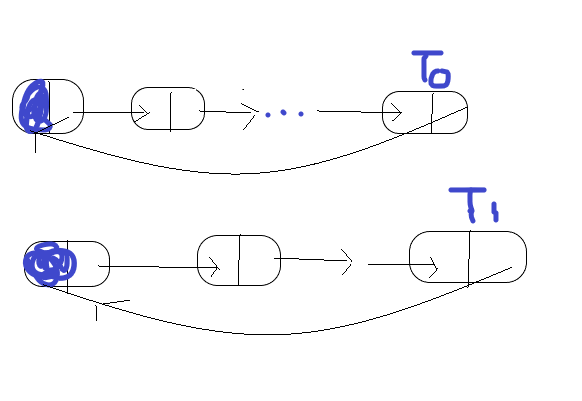
Step one:
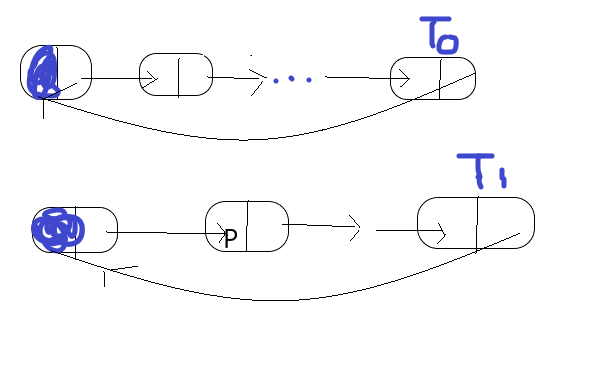
The second step:
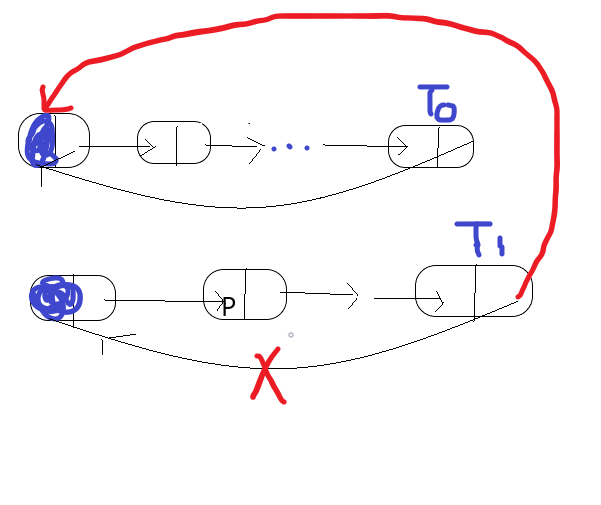
The third step:
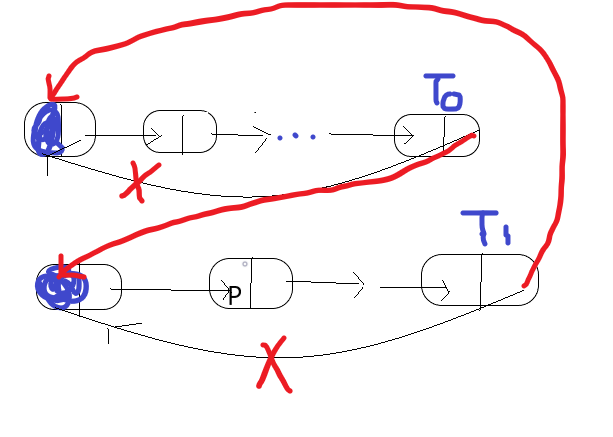
Then beautify it:
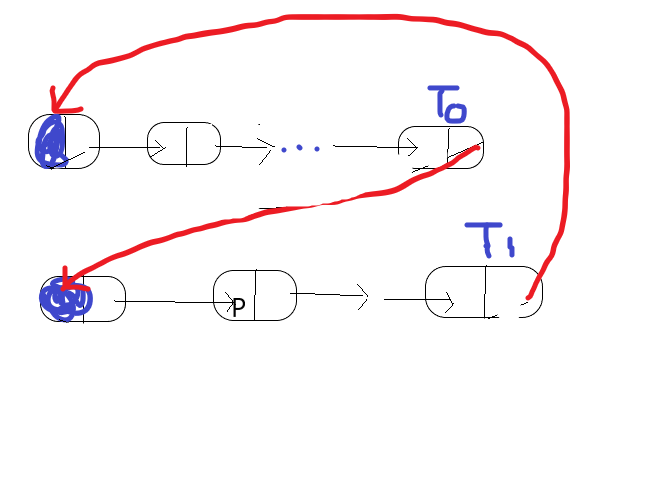
At this point, the combination of two circular lists into a circular list is completed.
Finally, a complete source code is attached:
#include<bits/stdc++.h>
using namespace std;
typedef struct
{
char username[20];
int id;
}User;
typedef struct LNode
{
User user;
struct LNode *next;
}LNode,*LinkList;
//Create a single chain table
LinkList CreateLinkList(LinkList L)
{
L=(LinkList)malloc(sizeof(LNode));
L->next=NULL;
return L;
}
//Insert 5 data by back interpolation
void InsertElem_Back(LinkList head)
{
int i=0;
LinkList r=head; //Every time data is added, r points to the tail node
for(;i<5;i++)
{
User user;
user.id=i;
strcpy(user.username,"gjw");
LinkList p=(LinkList)malloc(sizeof(LNode));
p->user=user;
p->next=NULL;
r->next=p;
r=p;
}
}
//Test output list
void TestList(LinkList head)
{
while(head->next)
{
User user=head->next->user;
cout<<user.username<<endl;
head=head->next;
}
}
//Convert single linked list to circular linked list
ChangeLinkListToCkList(LinkList head) //Here, just point the last tail pointer to the head node
{
LinkList p,p2=head,p1=head;
while(p2){ //The last p is the pointer of the link list to the end node
p=p2;
p2=p2->next;
}
while(p!=head) //The last head is the pointer to the penultimate tail node
{
head=head->next;
}
head->next=p1;
}
//Test cycle list
void TestCKList(LinkList head) //Note here that the header node has no data, so it will output its address value
{
int num=0;
while(head&&num<10)
{
head=head->next;
num++;
cout<<head->user.username<<endl;
}
}
//Add data to circular linked list
void AddElemIntoCKList(LinkList head,int index,User user)
{
LinkList p=(LinkList)malloc(sizeof(LNode));
p->user=user;
int i=0;
for(;i<index-1;i++) //Here, the previous node of the target location is returned
{
head=head->next;
}
p->next=head->next; //Point the target node to the node at the current target location
head->next=p; //Point the previous node of the target location to the target node, and then the target node completes the insertion operation
}
//Delete node at position i
void DeletElemFromCKList(LinkList head,int index)
{
int i=0;
for(;i<index-1;i++) //Here, the previous node of the target location is returned
{
head=head->next;
}
LinkList p=head->next;
head->next=head->next->next;
free(p);
}
//Get tail pointer of linked list
LinkList GetTails(LinkList head,int i)
{
LinkList p;
int index=0;
while(head && index<i)
{
p=head==0?p:head;
head=head->next;
index++;
}
return p;
}
//Merge two circular lists into one
void ContactCKList(LinkList tails_0,LinkList tails_1)
{
LinkList p=tails_1->next->next; //Find the first element node of the second circular list
tails_1->next=tails_0->next; //The tail node of the second linked list points to the head node of the first linked list
tails_0->next=p; //The tail node of the first linked list points to the first element node of the second linked list
}
int main()
{
LinkList L;
User user;
//Create a single chain table
LinkList head=CreateLinkList(L);
//Insert a piece of data by back interpolation
InsertElem_Back(head);
//Test output list
//TestList(head);
//Change single chain list to circular chain list
ChangeLinkListToCkList(head);
//Test cycle list
//TestCKList(head);
//Loop list add data to position i
//int i=3;
//user.id=0;
//strcpy(user.username,"px");
//AddElemIntoCKList(head,i,user);
//Delete node at position i
//DeletElemFromCKList(head,i);
//Merge two circular lists into one
LinkList head1=CreateLinkList(L); //Create a new single chain table
InsertElem_Back(head1); //Add 5 data to linked list
ChangeLinkListToCkList(head1); //Convert the list to a circular list
LinkList tails_0=GetTails(head,5); //Get the tail pointer of the first linked list
LinkList tails_1=GetTails(head1,5); //Get the tail pointer of the second linked list
ContactCKList(tails_0,tails_1); //Merge two circular lists into one
return 0;
}